Pandora is an irregularly shaped moon that orbits Saturn. It is covered in tiny particles of ice, giving it a potato-like appearance. Unlike other moons such as Hyperion, Pandora’s craters are filled with debris. The surface of Pandora is also marked by interesting grooves and protrusions.
One of the reasons Pandora is significant is because it, along with its neighboring moon Prometheus, plays a role in guiding the particles of Saturn’s F ring to form a separate ring.
Pandora has a diameter of approximately 84 kilometers (52 miles).
Exploration
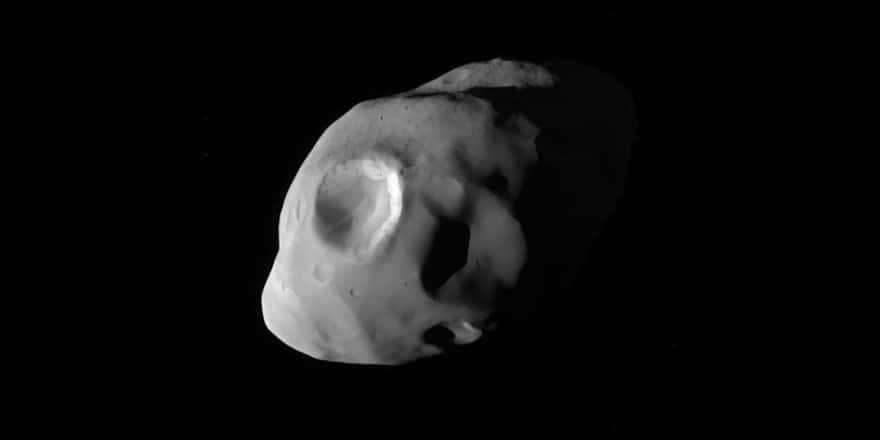
Pandora, a moon of Saturn, was first observed by the Voyager 1 scientific team in October 1980.
Designation
Originally, the moons of Saturn were named after Titans and their offspring from Greco-Roman mythology. However, as more moons were discovered, scientists started to select names from different mythologies, including Gallic, Inuit, and Norse legends.
In Greek mythology, Pandora was a magnificent piece of artwork that the gods transformed into a mortal woman. It was said that her insatiable curiosity led to the release of various calamities upon the world when she opened a forbidden box and set free wicked creatures. However, she also brought hope into the world as it was the final “creature” to emerge from the box. Here, you can find stunning, high-quality images of Pandora, the moon of Saturn, captured from outer space.
So now you know, which planet’s satellite is Pandora.
Photographs

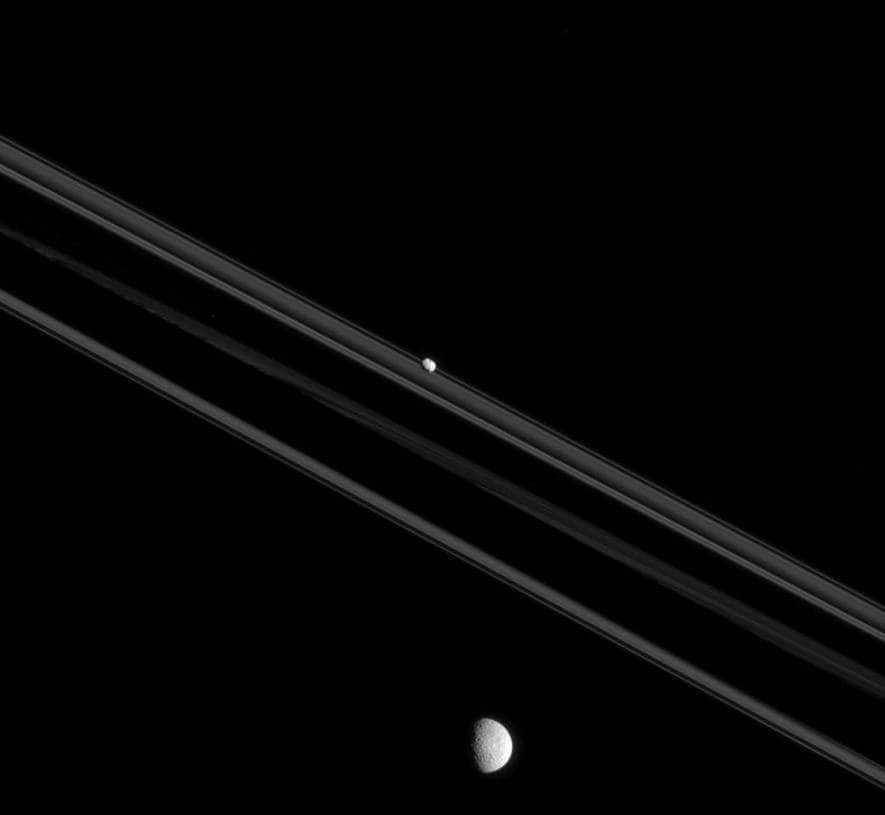
This picture was captured by the Cassini spacecraft on July 26, 2015 and displays Mimas and Pandora. Pandora is an irregularly shaped moon with a diameter of 81 kilometers. On the other hand, Mimas is much larger with a diameter of 396 kilometers and has a spherical appearance. The shapes of these moons are significant as they provide insights into their formation and history. For instance, it is possible that Pandora formed through the merging of ring particles attracted to its core. The unlit side of the rings was observed using a narrow-angle camera. The Cassini spacecraft is currently positioned 781,000 kilometers away from Pandora, with a scale of 5 kilometers per pixel. In addition, it is 1.4 million kilometers away from Mimas, with a scale of 8.4 kilometers per pixel. The Cassini program is a collaborative effort between ESA, NASA, and the Italian Space Agency, with the team based at LRD. Furthermore, the two onboard cameras were also developed by this team. The extracted images are processed in Boulder, Colorado.
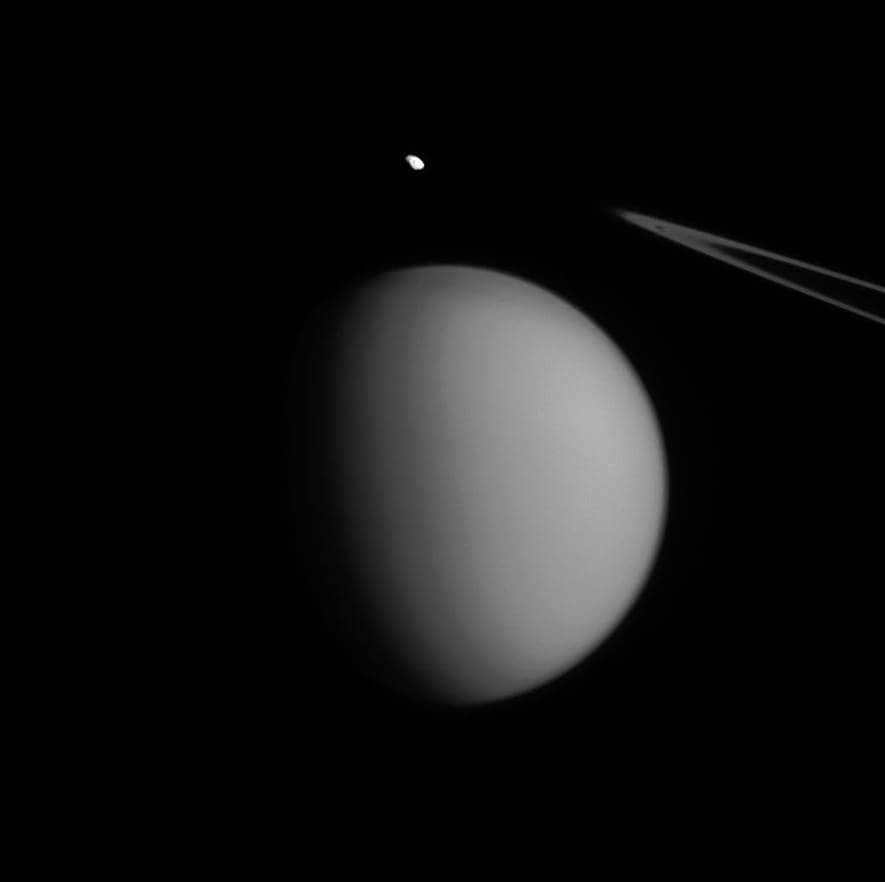
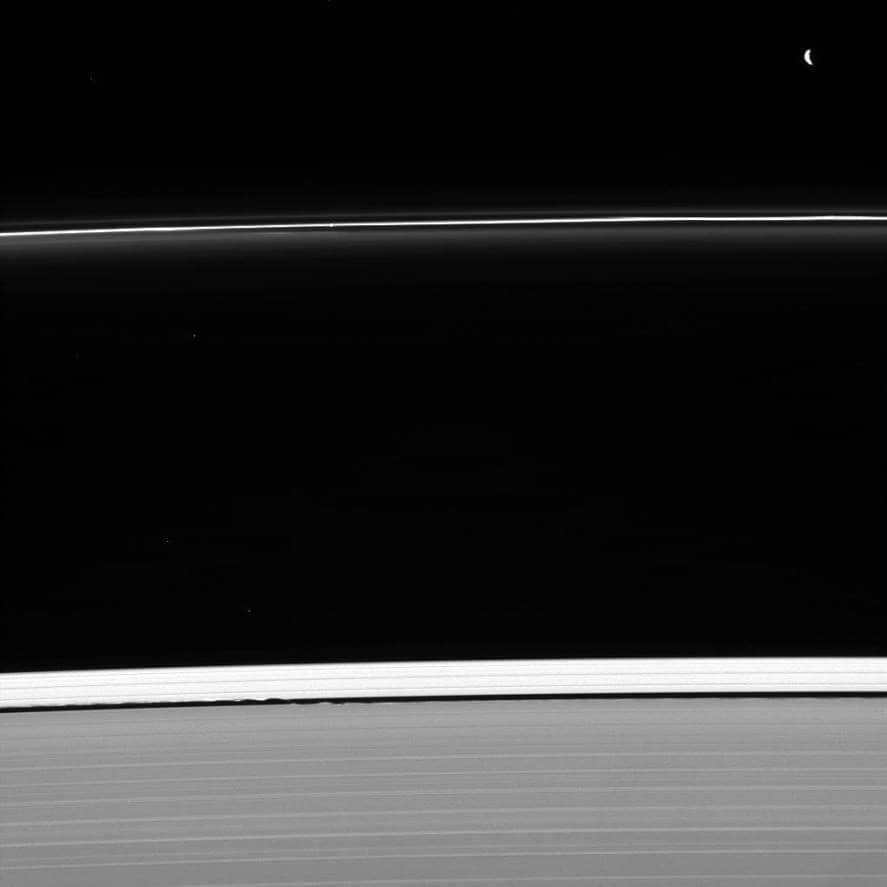
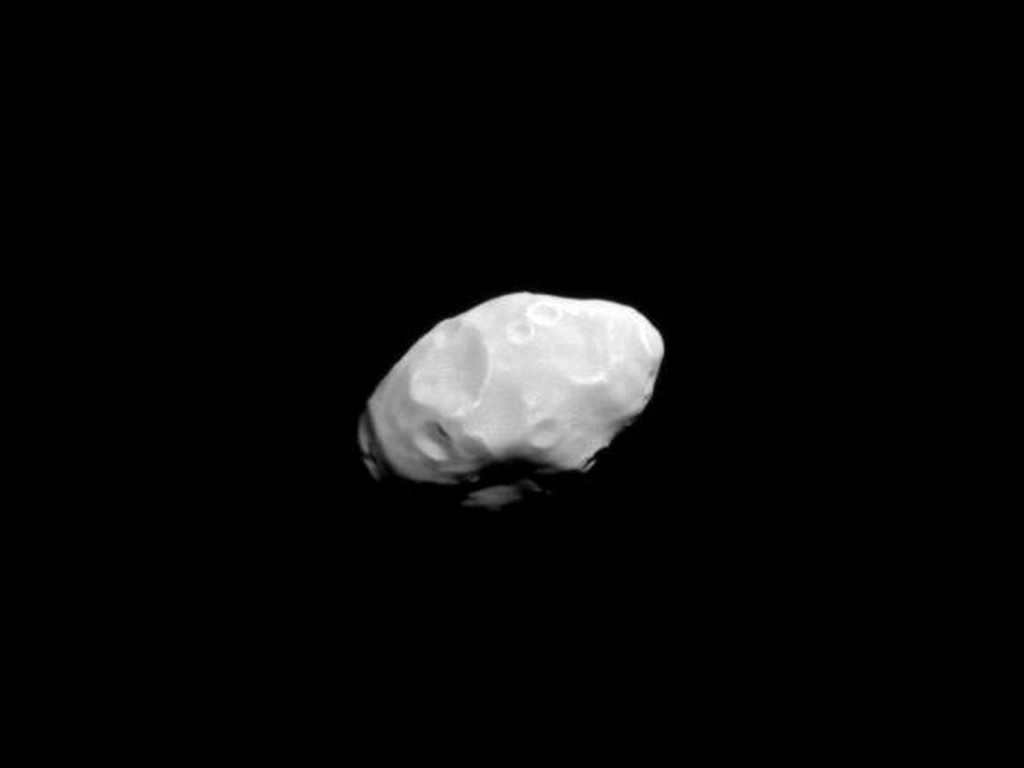
Scientists frequently uncover new information about familiar celestial bodies. For instance, it was quite astonishing to discover that Triton, the moon of Neptune, occasionally experiences blue methane snowfall. However, the reverse is also true. Pandora, one of Saturn’s satellites, was previously believed to be the moon responsible for shepherding the planet’s rings, but it has since relinquished its title.
Distinctive features of Pandora
Pandora is the fifth farthest moon from Saturn. Due to its close proximity to Saturn’s thin and isolated F ring, it was initially believed to be a shepherd companion – a moon that maintains the rings in a steady position around the planet through its gravitational force. However, it was eventually discovered that Pandora itself is shepherded. Its unique characteristics contribute to this:
- Pandora is not the largest moon, with an average diameter of 82 kilometers and a maximum linear dimension of 104 kilometers. Among Saturn’s satellites, it ranks 12th in size. It is 20 kilometers smaller than its neighbor, Prometheus, which is equivalent to the entire radius of Pan, Saturn’s closest satellite.
- Pandora, Saturn’s inner moon, has a mass of 1.4-10 17 kilograms, which is remarkably light. This lightness can be attributed to the moon’s unique structure, similar to that of its neighboring moons. Pandora can be described as a “pile of rubble,” with various sized rocks held together by dust and gravity, giving the appearance of a single body. The composition of these rocks is primarily ice, as evidenced by the satellite’s high albedo, or light reflectivity, exceeding 60% of the incoming light. This indicates that the surface of Pandora is predominantly icy. The density of these ice boulders is remarkably low, measuring only 0.6 g/cm 3 .
- Pandora completes a full orbit around Saturn in just 0.629 Earth days. In the same amount of time, it also rotates on its axis, similar to how the Moon rotates around the Earth. This makes Pandora a synchronous satellite. What makes this even more remarkable is that Pandora’s orbit is directly above Saturn’s equator, something that only 8 out of Saturn’s 63 satellites can claim.
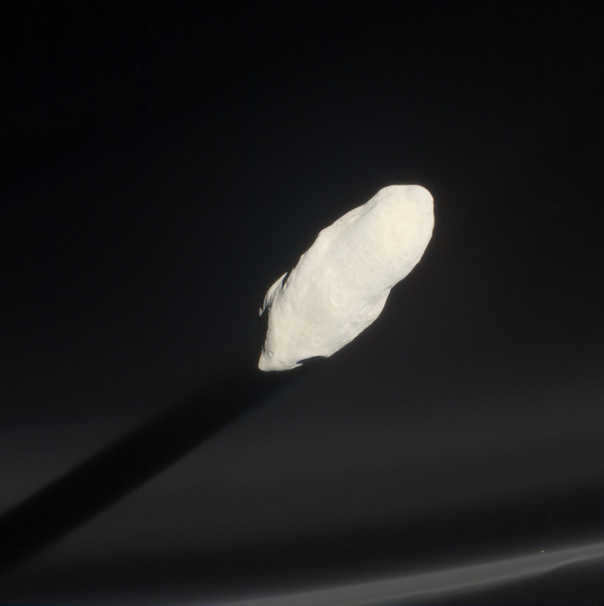
Prometheus throws a shadow across the F ring
The F ring of Saturn was graced by Prometheus, the second satellite in proximity. However, there are notable differences between Prometheus and its companion Pandora. Pandora is 12% lighter and positioned 700 kilometers further from the ring compared to Prometheus. Moreover, Prometheus orbits on the inner side and rotates slightly faster than Pandora, which influences the strength of their impact. Recent calculations have revealed that Prometheus not only exerts a dominant influence on the ring, pulling matter from it and forming knots, but also affects the orbit of Pandora itself. The most significant orbital shifts occur approximately every 6.2 years when the satellites come close to each other at a distance of 1400 kilometers.
What makes Pandora special?
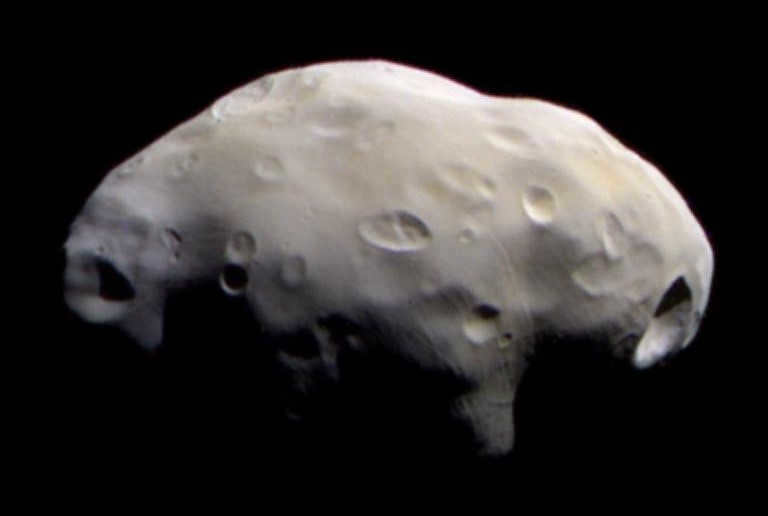
An image depicting Pandora in altered colors
Due to Pandora having a gravitational force that is 1600 times weaker than that of Earth, an individual riding a regular moped would be able to traverse between the moons as they draw closer. However, this journey would require nearly 24 hours of continuous flight, with no possibility of immediate landing. In the event that the moped rider is fortunate enough to avoid becoming trapped in orbit and actually makes contact with the surface of Prometheus, they would experience a prolonged bouncing effect, similar to that of a rubber ball, until all momentum is exhausted. These repeated bounces would leave significant marks on the satellite’s terrain, as both Prometheus and Pandora are composed of fine, lightweight dust on their upper layers.
The background of Pandora exploration
Initial phase
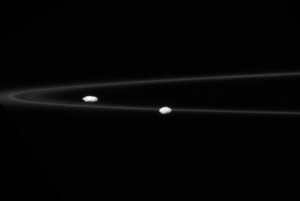

Pandora, one of Saturn’s satellites, was first discovered by Stephen Collins, an American astronomer who has been a part of various interplanetary missions, including the Deep Impact mission that involved launching a 375-kilogram projectile into the Tempel-1 comet.
Collins discovered Pandora and Prometheus, another moon of Saturn, simultaneously in a photograph taken by the Voyager 1 probe in October 1980 as it passed by Saturn. Voyager 1, which was launched in 1977, has traveled an incredible distance, covering almost 20 billion kilometers from the Sun as of October 2015.
The Voyager-2 spacecraft captured the most remarkable image of Pandora in the 20th century, just 6 hours before reaching its closest point to Saturn, which was over 300,000 kilometers away from the moon. Although the photo did not provide a wealth of useful information, astronomers were able to deduce Pandora’s orbit, size, shape regularity, and the extent of its damage.
It is worth noting that Saturn’s F ring acts as a shepherd to both Pandora and Prometheus, two of its satellites.
Despite the lack of detail in the photo, it was not the least impressive image in the history of space exploration. Other Saturnian satellites appeared as mere specks of light to the Voyager spacecraft. The initial photo of Pandora exemplifies this.
The studies conducted by the Hubble Space Telescope, which was launched into Earth’s orbit in 1990, proved to be significantly more beneficial. With the assistance of this advanced technology, scientists were able to determine the precise thickness of Saturn’s rings, as well as analyze their composition through spectrographic analysis of satellites. These findings have played a crucial role in developing theories about the composition of Saturn’s moons, including the extensive analysis of Pandora. However, the most invaluable and detailed information about the moon was acquired from the continuous monitoring conducted by the Cassini-Huygens probe, which has been observing the Saturn system for a remarkable span of 11 years.
The Cassini-Huygens probe: a complex mission to explore Saturn’s secrets
The Cassini-Huygens probe derives its double name from its intricate design – consisting of two independent devices until their separation in 2005. The Cassini space station was primarily responsible for orbit exploration, while the Huygens landing module successfully touched down on Titan, Saturn’s largest satellite. Titan, larger than Mercury, boasts its own atmosphere and remains a captivating subject of study. The probe’s two components pay homage to the groundbreaking work of scientists Giovanni Cassini and Christian Huygens, who were instrumental in discovering Saturn’s initial five satellites.
Cassini captured an incredible image of Pandora’s day side in 2010, taken from a remarkable distance of 101,000 kilometers (see the first photo in this article). The photograph vividly showcases the sediment on the expansive craters, hinting at the hidden depths concealed beneath the dust, a testament to the marvels waiting to be unraveled.
It is essential that information is able to be verified, as any unverifiable information may be subject to questioning and potential deletion.
Feel free to enhance this article by including links to reliable and authoritative sources.
This notation was added on May 14, 2011.
Pandora is a moon belonging to the fictional planet Polyphemus, which orbits the star Alfa Centauri A (ACA). Pandora serves as the backdrop for James Cameron’s film Avatar. This celestial body is home to a highly intelligent humanoid species known as the Na’vi.
Description
Despite being a moon orbiting Polyphemus, Pandora bears a striking resemblance to Earth rather than the Moon. It shares similar characteristics in terms of size, atmospheric composition, and physical appearance. Even the landscapes, including continents and islands, are encompassed by vast seas of the same mesmerizing blue hue. The clouds exhibit a diverse range, ranging from delicate, feather-like white formations to menacing, thunderous storm clouds. The planetary surface showcases a diverse topography, boasting majestic mountains, winding valleys, deep gorges, serene lakes, and meandering rivers. The planet teems with abundant vegetation, with lush forests carpeting most of the land, while entire islands of algae float in the vast oceans. Massive herds of herbivorous creatures gracefully migrate across the expansive prairies, while colossal winged beings majestically soar through the skies above.
However, Pandora is far from being similar to Earth; its seemingly heavenly appearance can be deceiving. The atmosphere on Pandora is comprised of a dense mixture of nitrogen and oxygen, with an unusually high concentration of carbon dioxide (approximately 19%). This elevated level of carbon dioxide can rapidly induce unconsciousness within a mere 20 seconds, ultimately leading to death in just 4 minutes for anyone foolish enough to venture without a proper breathing apparatus. Furthermore, the atmosphere also harbors a continuous emission of another toxic gas known as hydrogen sulfide, which is produced by the numerous active volcanoes scattered across the planet.
Moreover, the plant life on Pandora is riddled with substances that render them unsuitable for human consumption. It is not uncommon to encounter plants adorned with poisonous thorns or fruits that have the potential to explode or spray corrosive sap.
The animals pose a threat to humans as well. Even a heavily armored hammerhead cannot be defeated by a large-caliber machine gun. Winged banshees swoop down from the sky to snatch unsuspecting prey. Tiny creatures and insects possess highly potent venom. The majority of the planet’s inhabitants have learned to defend themselves, and this has influenced the character of the Na’vi.
During dark nights (which are relatively infrequent here), living organisms emit a phosphorescent glow in various colors of the rainbow, creating a dazzling display that can mesmerize those who are unfamiliar with it. On a spiritual level, an unparalleled harmony permeates all life on Pandora. Those who are able to embrace it will discover a sense of peace and tranquility like never before.
Physical characteristics
Pandora has a diameter of approximately 0.9 times that of the Earth (11,448 km). It has a mass that is 72% of Earth’s and a surface gravity that is 20% lower. The air on Pandora has an unusually high concentration of carbon dioxide and xenon, making it 20% denser than Earth’s atmosphere. Despite its low mass, Pandora is able to maintain such a dense atmosphere due to its orbit between two radiation belts of Polyphemus. These belts reflect most of the solar wind that would otherwise blow away the atoms of the upper atmosphere.
Structure of Pandora
Pandora shares a similar internal structure to that of Earth. It consists of a core made up of liquid iron, a flexible mantle, and a mostly solid crust. Just like Earth, Pandora derives its heat from two sources: the decay of radioactive isotopes and the energy from gravitational compression during its formation. However, Pandora has an additional and much more potent source of energy, which is tidal forces. The gravitational pull from the nearby inner and outer satellites, along with Polyphemus, create intense tidal forces on Pandora.
This excess energy leads to faster continental drift and more violent collisions and breaks between tectonic plates. As a result, Pandora lacks large continents and experiences heightened volcanic and geothermal activity.
Pandora’s liquid iron core and the swirling currents within it produce a dual-pole magnetic field that closely resembles Earth’s. This magnetic field serves as a shield, safeguarding the planet’s surface from cosmic rays and particles expelled by the stars within the Alpha Centauri system. Additionally, the anobtanium deposits give rise to strong magnetic fields, leading to distinctive localized disruptions.
Furthermore, the magnetic field of Pandora interacts with the significantly stronger field of Polyphemus. This interaction can result in the radiation trapped in the magnetic field of the giant being channeled to the surface of Pandora, which can have unfavorable effects. Occasionally, the arrangement of the fields gives rise to the creation of magnetic induction tubes that connect the poles of the planets. The current flowing through these tubes can reach millions of amperes, leading to alterations in the electrical charge of both celestial bodies. These alterations are evident in intense storms and other electromagnetic occurrences.
Surface
The land-to-water ratio on Pandora is different from Earth’s, with more land and less water. However, due to its fragmented nature, there are no continents similar in size to Earth. The presence of oceans helps to regulate the temperature, resulting in no desert regions on Pandora. The polar ice caps are also smaller and float freely due to the absence of solid support beneath them.
One notable feature of Pandora is its high volcanic activity. Volcanic eruptions occur both on land and under the ocean. Many mountains and surface formations are of volcanic origin. The planet is also dotted with hot springs and geysers, and there are even rivers where the water boils at the source. As a result, the air on Pandora contains a high concentration of hydrogen sulfide, which is toxic to unprotected humans.
The landscape on Pandora is more dynamic compared to Earth, as it is constantly shaped by strong winds. The atmosphere on Pandora is denser, causing the sand grains carried by the wind to be larger and more energetic. This leads to a faster aging process of exposed rocks, resulting in the production of significant amounts of sediment that are then carried away by rivers.
Atmosphere
Due to high concentrations of hydrogen sulfide and carbon dioxide in Pandora’s atmosphere, it is not suitable for human habitation. However, with the use of breathing devices that filter out these gases, humans are able to navigate the planet without the need for heavy compressed air tanks.
The increased air resistance on Pandora, which is 20% higher than that on Earth, has the following implications:
- With a lower limiting velocity of descent, the Na’vi on Pandora have the advantage of experiencing a much slower free fall speed due to the planet’s low gravity (which is 20% less than Earth’s). On Earth, the maximum steady-state fall speed without a parachute is approximately 180-200 km/h near the surface, and up to 300 km/h when falling head-down in Earth’s atmosphere. However, on Pandora, even when falling from a crane, tree, rock, or stump, there is a greater chance of surviving the fall without serious injuries. Even if they were to fall into water with their limbs spread out, the impact would not be strong enough to cause unconsciousness. Additionally, the Na’vi have some control over the process of falling by bending their bodies to land in a safer location.
- Flying creatures benefit from not only the reduced gravity, which makes them lighter, but also from the denser air, which offers more resistance to their wings – each flap generates more lift. However, the dense atmosphere necessitates that their bodies possess excellent aerodynamic qualities in order to achieve high speeds.
- Plants must withstand stronger winds due to the higher air density, which results in more kinetic energy in the air. Leaves, branches, and tree trunks must be stronger and/or more flexible to prevent breakage.
Among the hazardous (toxic) components of Pandora’s atmosphere are:
- The noble gas xenon (Xe) makes up 5% of Pandora’s atmosphere, along with carbon dioxide, which results in a 20% increase in density compared to Earth’s atmosphere. When xenon concentrations exceed 60%, it has an anesthetic effect on humans, although the amount of xenon present in Pandora’s atmosphere does not affect cognitive function. The high atmospheric density makes breathing challenging, particularly during exhalation, increases the likelihood of hypothermia in cold weather, and reduces running speed while also lowering the human voice.
- Pandora’s atmosphere contains 19% carbon dioxide (CO2), which is 125 times higher than that found on Earth. Occasionally, there are carbon dioxide releases from underground pockets during periods of heightened seismic activity, leading to a rapid increase in carbon dioxide concentration within specific areas.
- The levels of hydrogen sulfide (H2S) vary in different regions of Pandora. It can be dangerous if the concentration in the air exceeds 0.03% for an extended period (0.05% for a brief period). Even a concentration as low as 0.001% can cause irritation to the respiratory tract and eyes.
The cycle of day and night
When the DIA and the ASA come together in the sky, the brightness increases by only 0.09-0.4% (depending on the distance between the ASA and the DIA). The orange hue of the ASA light goes unnoticed, but as the stars move apart, it becomes clearly visible in the areas that are shielded from the ACA rays. At its farthest distance, the ASB is 2700 times less bright than the ACA and does not have a noticeable illuminating effect on the planet. However, it remains in the sky as a small, intensely bright orange disk. The third component of the Alpha Centauri system, ACC, is a red dwarf that cannot be seen by the naked eye from Earth, but can be faintly observed from Pandora. On the other hand, our Sun will shine as one of the brightest stars in the Pandorian sky, positioned in the constellation Cassiopeia.
Due to the significant inclination of the axis (29°), the duration of daylight and darkness undergoes significant fluctuations throughout the seasons in the circumpolar areas of Pandora. Furthermore, the elliptical nature of Polyphemus’ orbit leads to temperature and luminosity fluctuations of up to 10%.
System
The most brilliant star in the Centauri constellation when viewed through a telescope. In general, there are three stars in orbit around each other. Alpha Centauri A (also known as ACA) is the largest of the three stars, measuring about 20% larger than our Sun. It is famous in the Avatar universe as the sun of Pandora, the homeland of the only known intelligent species. Alpha Centauri B is approximately 15% smaller than our Sun. Alpha Centauri C is a red dwarf. The discoveries related to the moons of the planet Polyphemus were even more impressive. On the fifth and sixth moons of Polyphemus, scientists found nitrogen and oxygen in addition to an ocean. Such an atmosphere can only be created by carbon-based life forms. While surface water reservoirs were discovered on other satellites of Polyphemus, their thin atmospheres were primarily composed of nitrogen and carbon dioxide, indicating that the planet was devoid of life.
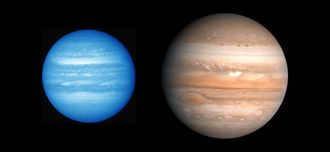
Even though Pandora’s entire world was crafted by artists and animators, scientists concur that in actuality, celestial entities within the same category may serve as habitats for a diverse range of life forms. Numerous gas giant planets have been detected in the vicinity of neighboring stars within our solar system. Certain of these planets are akin in size to Jupiter and are composed primarily of gaseous substances. For life forms, such entities are scarcely suitable due to their predominantly hydrogen-based composition. However, the focus of scientists is drawn towards the moons of gas giants, where surface conditions are more conducive to the evolution of living organisms.
By utilizing the James Webb Space Telescope (JWST), scientists aim to examine the makeup of the atmospheres of numerous gas giant moons. An essential objective in the ongoing quest for extraterrestrial life is to identify the presence of gases like oxygen, carbon dioxide, and water vapor on the surfaces of these moons.
It should be emphasized that simply having the aforementioned gases in the atmosphere does not guarantee the existence of favorable conditions for life. Other factors such as gravity and the range of temperature extremes also play a significant role. Experts suggest that the likelihood of discovering life may be greater on the moons of gas giants rather than on planets similar in size to Earth or so-called “Super-Earths”. Currently, inhabited moons only exist in the realm of science fiction, but who can say what the future holds? Perhaps sooner than we think, fiction will become reality.
Did you know?
- Did you know that Pandora has an interesting feature called the Big Blue Spot? It’s similar to Jupiter’s Big Red Spot and is the reason why the moon got its name. The spot resembles an eye, just like the famous Cyclops from Greek mythology.
- Here’s another interesting fact: in the novels by the Strugatsky brothers, there is a planet named Pandora. These novels, mostly written in the 1960s, explore the fascinating world of Noon.
- PandoraPedia software
- Na’Vi Comprehensive Dictionary Translator
- Online encyclopedia for the fictional planet Pandora
- James Cameron – Avatar. Archived from the original source on April 13, 2012.
- Article “Insights into Pandora”. na-vi.ru. (unavailable link – history) Verified November 8, 2009.
- A brief overview of Pandora on YouTube.
Important Message
Additional Information

Greetings! I am Dmitry Ermokhin, a skilled automotive technician, car expert, and professional writer. Today, we will delve into the topic of the Pandora satellite and its association with the various planets within our solar system.
Pandora, one of Saturn’s moons, was initially found in 1980 by the American spacecraft Voyager 1. It was given its name in honor of the Greek mythological figure. This satellite possesses a unique structure and is relatively petite in size.
Pandora is situated within Saturn’s F-hoop ring, encircling the planet at its equator. It is positioned approximately 141,000 kilometers away from Saturn and completes a full orbit in roughly 15 hours and 15 minutes.
Satellite Pandora and the Ring System of Saturn
The ring system of Saturn is well-known for its grandeur, and an important player in this system is the satellite Pandora. Pandora serves as a “shepherd” for a distinct ring known as the F-ring. Its gravitational influence plays a crucial role in maintaining the shape of this ring and preventing it from merging with the neighboring rings.
The ring system of Saturn is a remarkable phenomenon within our solar system, and studying its structure and origins enhances our understanding of the formation of planetary systems in general.
The Significance of Investigating Pandora’s Moon
The examination of Saturn’s moons, specifically Pandora, holds great importance in our study and exploration of the universe. It aids in our comprehension of planetary and satellite formation processes, as well as the composition and structure of celestial bodies.
Voyager and Cassini missions have yielded extensive knowledge about Pandora and other moons of Saturn. Through these missions, we have acquired valuable insights into the moon’s appearance, composition, and gravitational interactions with both the planet and other celestial entities within the Saturn system.
Conclusions
Therefore, Pandora represents a celestial body orbiting Saturn, which happens to be the sixth planet from the Sun within our solar system. The existence and unique attributes of Pandora contribute significantly to the comprehension of Saturn’s ring system and the process of planet formation. The exploration of outer space has provided us with invaluable insights into this specific moon and its surrounding environment.
Fact-checking, which involves verifying the accuracy and truthfulness of the information presented in a text, is crucial for identifying and rectifying any dubious data, thus ensuring the reliability and authenticity of the material.

Each planet in the “Star Wars” movie has its own distinct atmosphere and character, from Tatooine with its double sunsets to Krypton with its remarkably advanced technology. These planets serve as the home to our heroes and the backdrop for epic events that shape the destiny of their respective universes.
Which movie planets stand out as the most remarkable? We’ve gathered five contenders with awe-inspiring worlds.
The World of Pandora
Featured Films: “Avatar” (2009), “Avatar: Path of Water” (2022).
Directed by: James Cameron.
In the enchanting universe of Avatar, Pandora serves as the exclusive habitat for a highly intelligent species, apart from the human inhabitants, of course. Situated as a moon of the majestic gas giant, Polyphemus, Pandora gracefully revolves around the star Alpha Centauri A within the Alpha Centauri triple star system. It is a mesmerizing satellite, brimming with captivating wonders.
Pandora, although classified as a satellite, is actually of comparable size to Earth. Not only are these two celestial bodies similar in size, but they also share similar conditions, atmospheric compositions, geological structures, and abundant vegetation. However, despite its paradisiacal appearance and striking similarities to our own planet, without the aid of a specialized breathing mask, human survival in this idyllic place is limited to mere four minutes, with loss of consciousness occurring within thirty seconds of breathing without a respirator.
It is not only the atmosphere that poses a danger to humans on Pandora. Nearly everything on this celestial body has the potential to be lethal. The plant life is unfit for consumption, insects are venomous, and certain animal species are impervious even to high-caliber firearms.
However, Pandora stands out not only for its perilous plant life and dangerous creatures, but also for the unique phenomenon that occurs every night – the planet begins to emit a mesmerizing glow. This glow illuminates the dark nights, causing almost all living creatures on Pandora to phosphoresce.
What truly sets Pandora apart is the spiritual connection that permeates its entire biosphere. The advanced fauna on the planet possess the ability to establish mental contact with one another by linking their nervous systems through special appendages. This connection, known as “tsaheilu” to the native Na’vi people, allows for a profound level of communication. In fact, Pandora itself has a collective consciousness, similar to a natural version of the internet known as Ava. Through Ava, beings on the planet can access the thoughts and emotions of others, creating a network that binds them all together.
Cybertron
The film: Transformers 3: Dark Side of the Moon.
Directed by: Michael Bay.
Animated series: “Transformers” (1984).
Directors: John Gibbs, Terry Lennon, Ray Lee, Jaho Hong.
The universe of “Transformers” features Cybertron, a fictitious mechanical planet. One account places it within the constellation Alpha Centauri, while another depicts it as a nomadic planet without its own star. This celestial body serves as the dwelling place for the Transformers, who are said to have been brought into existence by an advanced race of mechanized beings known as the Quintessons. These merciless masters subjected their creations to the status of slaves, segregating them into two classes: gladiators and laborers, now recognized as the Decepticons and Autobots.
Due to the abundance of sources in the Transformers universe, such as comic books, movies, games, and animated series, there exist various interpretations of the origin story. The second canon posits that the Transformers, a race capable of transforming into mechanical beings, were brought into existence by the ancient deity Primus. For countless centuries, Primus engaged in a relentless battle against his nemesis, Unicron, who embodied darkness and malevolence. Following his triumph, Primus made the decision to transform himself into a planet, a sanctuary for his creations. As for the fate of Unicron, it remains shrouded in mystery: certain accounts suggest that he was deactivated and transformed into a moon orbiting Cybertron, while others claim that he roams the galaxy in search of planets to consume. Alternatively, some propose that over time, Unicron has disintegrated into cosmic dust and evolved into the planet known as Earth.
From a geological perspective, Cybertron consists of metals that are identical to those found on Earth, with the exception of Cybertronium. The planet’s appearance is far from appealing, as it is characterized by an uneven and mottled surface, riddled with a network of tunnels that are both natural and man-made. The surface itself is covered in massive metal plates, separated by fault lines, and adorned with mountains and deserts – one of the largest being known as the Rusty Sea. Once bustling with numerous cities, Cybertron has been ravaged by endless wars, leading to the obliteration of these urban centers.
A perpetual darkness looms over the planet’s sky, preventing sunlight from reaching the surface. However, an atmosphere exists, allowing individuals to traverse the planet without the need for a spacesuit. In addition, Cybertron is susceptible to corrosive rain, which can erode the metal shells of machines.
There are currently a total of seven movies in the “Transformers” franchise. The first five films were directed by Michael Bay and included scenes set on the planet Cybertron. Following a reboot of the franchise, two new movies were released, namely “Bumblebee” and “Transformers: Rise of the Beastmen”.
Arrakis
The film: “Dune” (2021).
Directed by: Denis Villeneuve.
Television series: “Dune” (2000).
Directed by: John Harrison.
Film: “Dune” (1984).
Directed by: David Lynch.
Arrakis was created by the science fiction writer Frank Herbert as the central planet and primary backdrop for a novel called Dune, which was first published in its entirety in 1965, along with its sequels. The planet is commonly referred to as Dune due to its secondary name, Arrakis.
After a trip to the Oregon Dunes National Recreation Area, the author found inspiration to craft a planet dominated by sand. The visit coincided with ongoing experiments in landscaping and sand movement control, which added to the author’s fascination. Throughout the work, an ecological theme is woven, but what makes the remote Arrakis truly exceptional and significant?
In the distant future, the world of “Dune” is ruled by a monarchy. After the rebellion of artificial intelligence, the use of computers is strictly prohibited. Interstellar travel relies on a special substance known as “spice,” which can only be found on one planet in the galaxy – Arrakis. This spice has numerous beneficial properties, including extending lifespan, enhancing human abilities, and, most importantly, enabling the prediction of future events. It is crucial for interplanetary navigation. However, this extraordinary substance is also highly addictive.
One of the notable features of Arrakis is its enormous sandworms, referred to as Shai-Hulud by the locals. These colossal creatures form the foundation of the planet’s ecosystem, as they generate sand and oxygen. Most significantly, these “desert makers” are responsible for producing the invaluable spice that shapes the world of the distant future.
The universe of “Dune” has gained a devoted following and has had a significant impact on popular culture, being adapted for the screen multiple times. It is thanks to Arrakis that George Lucas was inspired to create Tatooine, the iconic desert planet, in a different fantastical universe.
Solaris
The film: “Solaris” (1972).
Directed by: Andrei Tarkovsky.
The film: “Solaris” (2002).
Directed by: Steven Soderbergh.
The planet Solaris first appeared in the novel of the same name by Polish writer and futurist Stanislaw Lem, which was originally published in 1961.
According to the narrative, the planet is 20% larger compared to Earth, has an unbreathable atmosphere, and is predominantly covered by ocean. The planet’s distinctiveness lies in its defiance of celestial mechanics. While investigating these anomalies, scientists have theorized that the ocean enveloping the celestial body is, in essence, a sentient entity, and it consciously influences the movements of Solaris in outer space.
Building upon these conjectures, Solaristics emerged as a discipline dedicated to comprehending this extraordinary life form and attempting to establish communication with it. Consequently, a scientific station was constructed on the planet’s surface, tasked with conducting research on this unparalleled phenomenon.
Let’s discuss the film adaptations of the novel, which is an interesting topic. One of the adaptations stands out as a truly unique case. Andrei Tarkovsky’s film is widely regarded as a masterpiece in the world of cinema, yet it is also considered the least faithful adaptation of the book. There is no denying Tarkovsky’s genius, but Stanislav Lem himself expressed a negative reaction to this particular adaptation, deeming it terrible. Tarkovsky took a different approach by creating a psychological film set in a confined space, but he chose not to depict the actual planet itself.
Ego
The film: “Guardians of the Galaxy. Part 2” (2017).
Directed by: James Gunn.
This planet’s history can be traced back to the 1960s, when Stan Lee and Jack Kirby, comic book writers, came up with the idea of introducing a one-of-a-kind character in the Thor series.
In the Marvel Cinematic Universe, Ego’s narrative has been altered. In the realm of Iron Man and the Avengers, Ego is not simply an experiment conducted by higher beings, but rather an ancient and godlike entity – a Celestial possessing immense powers and an insatiable thirst for supremacy. Upon first manifesting, Ego took the form of a colossal brain with the ability to manipulate matter – it was through this skill that he fashioned the husk which eventually transformed into his celestial form. The malleability of his physicality grants the Celestial the capacity to assume any appearance he desires. Ego can fashion lush jungles or desolate wastelands, and his surface may sprout humanoid beings or tentacle-like appendages, employed by the sentient planet to safeguard itself from unwanted intruders.
Celestial has the ability to control both its own internal temperature and the temperature on its surface, as well as alter the composition of the surrounding atmosphere. Additionally, it possesses the power to obliterate other planets and absorb massive amounts of energy.
Furthermore, Ego is revealed to be Peter Quill’s father. Interestingly, this familial connection plays a crucial role in Star Lord’s ability to withstand the influence of the Infinity Stone in the first installment of the space team trilogy. It may seem improbable for a regular human to be descended from a planet, but in the film adaptation, Ego not only retains his original appearance as a celestial being with a face, but also assumes the guise of a humanoid, traversing the galaxy in secret as he seeks to expand his influence to as many star systems as possible.





